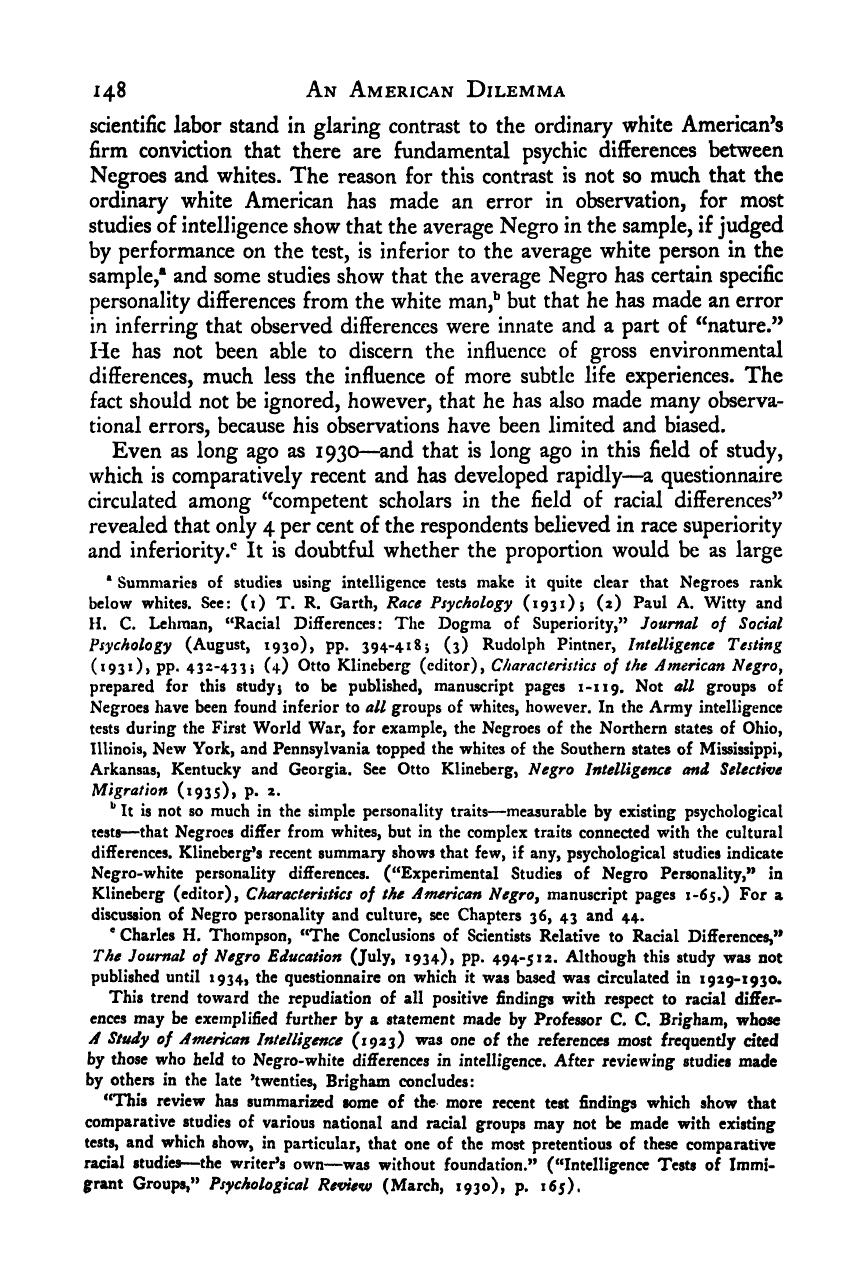Note: Gunnar Myrdal died in 1987, less than 70 years ago. Therefore, this work is protected by copyright, restricting your legal rights to reproduce it. However, you are welcome to view it on screen, as you do now. Read more about copyright.
Full resolution (TIFF) - On this page / på denna sida - II. Race - 6. Racial Characteristics - 3. Psychic Traits

<< prev. page << föreg. sida << >> nästa sida >> next page >>
Below is the raw OCR text
from the above scanned image.
Do you see an error? Proofread the page now!
Här nedan syns maskintolkade texten från faksimilbilden ovan.
Ser du något fel? Korrekturläs sidan nu!
This page has never been proofread. / Denna sida har aldrig korrekturlästs.
148 An American Dilemma
scientific labor stand in glaring contrast to the ordinary white Americanos
firm conviction that there are fundamental psychic differences between
Negroes and whites. The reason for this contrast is not so much that the
ordinary white American has made an error in observation, for most
studies of intelligence show that the average Negro in the sample, if judged
by performance on the test, is inferior to the average white person in the
sample,® and some studies show that the average Negro has certain specific
personality differences from the white man,** but that he has made an error
in inferring that observed differences were innate and a part of ‘^nature.”
He has not been able to discern the influence of gross environmental
differences, much less the influence of more subtle life experiences. The
fact should not be ignored, however, that he has also made many observa-
tional errors, because his observations have been limited and biased.
Even as long ago as 1930—and that is long ago in this field of study,
which is comparatively recent and has developed rapidly—a questionnaire
circulated among ^‘competent scholars in the field of racial differences”
revealed that only 4 per cent of the respondents believed in race superiority
and inferiority.^ It is doubtful whether the proportion would be as large
• Summaries of studies using intelligence tests make it quite clear that Negroes rank
below whites. See: (x) T. R. Garth, Race Psychology (1931)5 (2) Paul A. Witty and
H. C. Lehman, ‘‘Racial Differences: The Dogma of Superiority,” Journal of Social
Psychology (August, 1930), pp. 394-4185 (3) Rudolph Pintner, Intelligence Testing
(1931), pp. 432-4335 (4) Otto Klineberg (editor). Characteristics of the American Negro^
prepared for this study 5
to be published, manuscript pages 1-119. Not all groups of
Negroes have been found inferior to all groups of whites, however. In the Army intelligence
tests during the First World War, for example, the Negroes of the Northern states of Ohio,
Illinois, New York, and Pennsylvania topped the whites of the Southern states of Mississippi,
Arkansas, Kentucky and Georgia. See Otto Klineberg, Negro Intelligence and, Selective
Migration (1935)1 p. 2,
^
It is not so much in the simple personality traits—measurable by existing psychological
tests—that Negroes differ from whites, but in the complex traits connected with the cultural
differences. Klineberg’s recent summary shows that few, if any, psychological studies indicate
Negro-white personality differences. (“Experimental Studies of Negro Personality,” in
Klineberg (editor). Characteristics of the American Negro
^
manuscript pages 1-65.) For a
discussion of Negro personality and culture, see Chapters 36, 43 and 44.
®
Charles H. Thompson, “The Conclusions of Scientists Relative to Racial Differences,”
The Journal of Negro Education (July, 1934)* PP* 494-512. Although this study was not
published until 1934, the questionnaire on which it was based was circulated in 1929-1930.
This trend toward the repudiation of all positive findings with respect to racial difiFer-
cnees may be exemplified further by a statement made by Professor C. C. Brigham, whose
A Study of American Intelligence (1923) was one of the references most frequently cited
by those who held to Negro-white differences in intelligence. After reviewing studies made
by others in the late ’twenties, Brigham concludes:
“This review has summarized some of the more recent test findings which show that
comparative studies of various national and racial groups may not be made with existing
tests, and which show, in particular, that one of the most pretentious of these comparative
racial studies—the writer’s own—was without foundation.” (“Intelligence Tests of Immi-
grant Groups,” Psychological Review (March, 1930), p, 165).
<< prev. page << föreg. sida << >> nästa sida >> next page >>